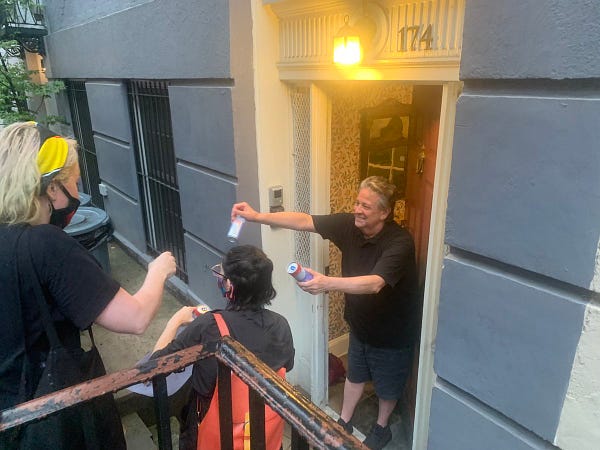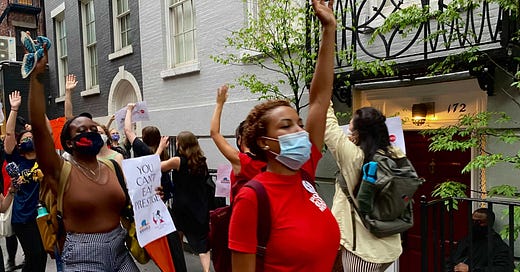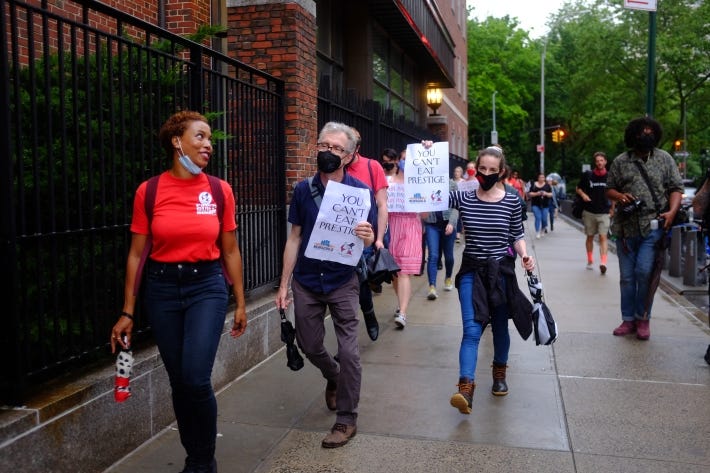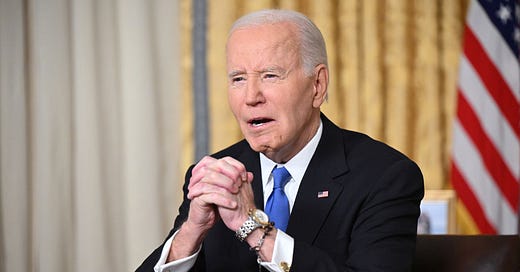
It's Good to Know Where Your Boss Lives
Anna Wintour won't come to the bargaining table. So her workers went to her house.

Hello! The Wednesday edition of our What Now newsletter has turned into a freewheeling forum for our bloggers to write about anything they feel like. We’re running today’s edition in full on the site to give you all a taste of what’s going on in the newsletter—we're doing everything from random food takes to richly reported dispatches like this.
Usually, though, What Now is only in email form, and only goes to our Steward-tier members. What Now also features weekly interviews with notable journalists, activists, and other important people, as well as our weekly news roundup, Man What the Hell. Stewards get all of that, every week, along with all of our published content, commenting privileges, and access to our private hangout space in Discord. If that sounds good to you, click here to subscribe starting at just $10 a month.
I don't know where Anna Wintour slept last night, but since 1992, one of her primary residences has been a townhouse at 172 Sullivan Street in Manhattan's Greenwich Village neighborhood. For the past two and a half years, Wintour, the legendary editor of Vogue and current Global Chief Content Officer of Condé Nast, has not deigned to appear at the bargaining table with unionized employees of her empire's most prestigious magazine, The New Yorker, or with committees from two of the company's digital media publications, Pitchfork and Ars Technica.
So last night, the unions came to her. A little after 7 p.m., about 100 Condé union members, News Guild representatives, and sympathetic freelancers and friends marched down Sullivan Street, yelling lines like "Condé Nasty you can't hide/ we can see your greedy side," and "Bosses wear Prada, workers get nada!" They waved signs with the New Yorker Union's rallying cry: "You can't eat prestige."
These were not, of course, Teamsters with tire-irons. Two generally relaxed NYPD officers in windbreakers shadowed the march as it moved through the Village, largely making sure traffic didn't interrupt the column at crosswalks. Organizers at the head shuffled everyone into two tidy files, which paraded in a long loop up and down the block. Outside of Wintour's apartment, a single extremely bored-looking security guard leaned on a stairway bannister. At one point, one of Wintour's neighbors came out and handed some of the picketers a few cans of hard seltzer.


(He may pay for that act later, when he sees Anna in the walled-in private garden that they share with other homes that sell for more than $12 million.)
Despite the exuberant vibe, the message was clear: we know where you live.
"We have to bring the fight to our bosses' doorsteps, so they can't ignore the issues we aim to correct," Natalie Meade, chair of the New Yorker Union, told Discourse Blog. "I think Condé Nast has really tried to disregard the union's presence and the improvements we've been able to fight for over the past three years, so we're here to remind them that we intend to organize until they meet our demands and give credit where it’s due.”
Even for the media industry, which is not inherently friendly to organized labor, Condé's attitude towards its unionized workers has been notably aggressive. The New Yorker Union Twitter feed contains an endless catalog of slights, ridiculous negotiating positions, and overt hostility from Condé management. This shouldn't come as a complete surprise, though. Salaries at the New Yorker scrape as low as $42,000, and both Condé and the magazine in particular are notorious for extracting labor in chaotic employment arrangements laced with low hourly rates, "permalance" work and the threat of ruthless dismissal -- things that the company's top brass will never have to face.
Meade explained that Wintour, in her role as Global Chief Content Officer, is seen as a proxy for Condé Nast CEO Roger Lynch, who decamped from New York for California early on in the pandemic. Wintour is also higher up the ladder than New Yorker editor David Remnick, who the New Yorker union confirmed hasn't been seen at the bargaining table since the unit's first session. (Remnick has been in charge of the New Yorker since 1998, and runs the magazine largely outside of Wintour's direct control.)
Before the pandemic, a lot of this direct union action played out in the office, where workers have at least some direct access to their bosses. But "the pandemic has forced us to be a little more combative with things like pickets," New Yorker Union secretary Hannah Aizenman said. Coming to someone's home is certainly combative, regardless of whether or not they were actually inside (Condé Nast did not respond to a request for comment on where Wintour was last night). A picket line in Greenwich Village feels completely appropriate when workers are forced to haggle for their livelihoods with people who almost literally live in ivory towers. The union movement at Condé Nast won't send Anna Wintour to the poorhouse, but it should remind her that there are people on both sides of the table.
They've been at that table for a long, long time. After an earlier clash and union victory on just cause language, bargaining is still stuck on several key areas, including a salary floor and healthcare costs. The unit is back at the table today, though it notes that management has long pursued a strategy of "delay, intransigence, and unresponsiveness." If that continues, the next step is a strike. The union announced on Monday that the units at the New Yorker, Ars Technica, and Pitchfork was "ready to strike," but has yet to announce a hard deadline. Tuesday's action, Aizenman said, was a show of force and intent, intended to create the pressure that makes a strike unnecessary.
"We're trying to show our bosses what it will be like if we do strike," Aizenman said. "It'll be like this every day."












